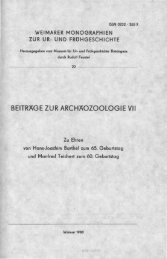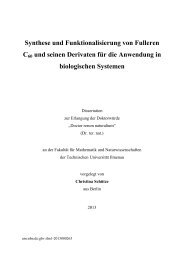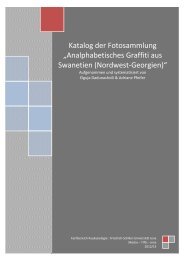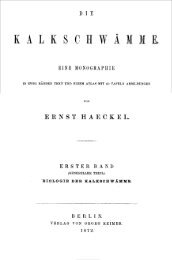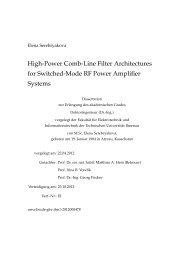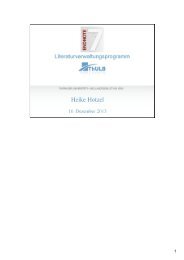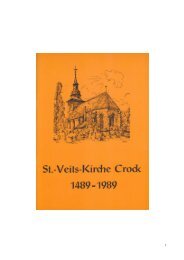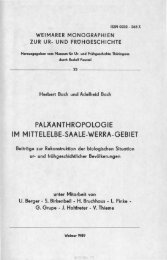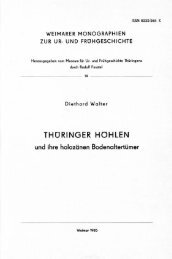|6.1 Synthesis of the Organic Ligands| was collected after cooling and washed with ether to give 163 mg (200 µmol, 50%) of the desired product as white off-white solid. Recrystallization from D 2 O yielded suitable crystals for X-ray diffraction. 9-ip 6-ip N N 10-ip 11-ip 4-ip 5-ip N N edip 2-ip CH 3 CH 2 Ar N N N N 1 H-NMR (D 2 O, 400 MHz): δ = 9.71 (d, 2H (6/9-ip) , 3 J = 8.7 Hz), 9.31 (m, 6H (4-ip,6/9-ip,11-ip) ), 9.04 (s, 2H (2-ip) ), 8.36 (dd, 2H (5/10-ip) , 3 J = 5.0 Hz, 3 J = 8.4 Hz), 8.30 (dd, 2H (5/10-ip) , 3 J = 5.1 Hz, 3 J = 8.4 Hz), 6.29 (s, 4H (CH2 -Ar)), 4.92 (q, 4H (CH2 ), 3 J = 7.0 Hz), 2.25 (s, 12H (CH3 -Ar)), 1.57 (t, 6H (CH2 ), 3 J = 7.2 Hz) ppm. 13 C-NMR (D 2 O, 100 MHz): δ = 147.05 (2C (4/11-ip) ), 140.07 (2C (2-ip) ), 137.20 (2C (6/9-ip) ), 136.73 (4C (2,3,5,6-Ar) ), 136.63 (2C (4/11-ip) ), 136.07 (2C (6/9-ip) ), 128.97 (2C (1,4-Ar) ), 126.72 (2C (5/10-ip) ), 126.40 (2C (5/10-ip) ), 126.03 (2C (7’/7”-ip) ), 125.63 (2C (7’/7”-ip) ), 120.01 (2C (3”/11’-ip) ), 119.46 (2C (3”/11’-ip) ), 118.80 (2C (3’/11”-ip) ), 113.00 (2C (3’/11”-ip) ), 50.64 (2C (CH2 -Ar)), 45.97 (2C (CH2 )), 15.67 (2C (CH3 -Ar)), 14.03 (2C (CH3 )) ppm. MS: (FAB) m/z = 812 (5%, [M+2Br] + ), 737 (80%, [M+Br] + ), 655 (30%, [M] + ), 407 (60%, [M-eip] + ), 249 (100%, [eip] + ). Crystals suitable for X-ray diffraction were obtained from D 2 O. Crystal data for edip: [C 42 H 40 N 8 ] 2+ [Br − ] 2 × 9 H 2 O, M r = 1014.23 g /mol, colorless crystals, size 0.05 × 0.05 × 0.04 mm 3 , monoclinic, space group P2 1 /n (No. 14), a = 14.988(3), b = 20.766(4), c = 16.172(3) Å, α = 90.00), β = 116.51(3), γ = 90.00°, V = 4504.2(16) Å 3 , T = 20°C, Z = 4, ρ calcd. = 1.496 g /cm 3 , µ (Mo-Kα) = 19.22 cm -1 , F(000) = 2100, 30434 reflections in h(-19/17), k(-25/26), l(-16/20) measured in the range 2.51° ≤ Θ ≤ 27.52°, completeness Φ max = 98.6%, 10221 independent reflections, R int = 0.1049, 5526 reflections with F o > 4σ Fo , 565 parameters, 0 restraints, R obs. = 0.0829, wR 2 obs. = 0.2074, R2 all = 0.1598, wR 2 all = 0.2421, GOOF = 1.028, largest difference peak and hole: 3.239/-1.511 e /Å 3 . The data file TT3999 includes the full crystallographic data and can be obtained from Dr. Helmar Görls (IAAC, FSU-Jena). In the molecular structure of edip. Hydrogen atoms (except H12a and H28a), solvent molecules and anions are omitted for clarity. Ellipsoids are drawn at 70% probability. |209|
|6.1 Synthesis of the Organic Ligands| 6.1.14 5,10-Dibromo-1H-imidazo[4,5-f][1,10]phenanthroline - Br 2 ip In a round bottom flask 368 mg (1.0 mmol) of 3,8-dibomo-1,10-phenanthrolindione, 280 mg (2.0 mmol) of hexamine and 385 mg (5.0 mol) of ammonium acetate were suspended in 10 ml of glacial acetic acid. After refluxing the resulting mixture for two hours, the volatiles were removed under reduced pressure. The resulting solid was dissolved in a small amount of water and neutralized with ammonia. Stirring this mixture over night yielded an off-white precipitate. The solid was filtered off, and washed twice with ethanol and ether and was dried under vacuum. Yield: 265 mg (700 µmol, 70%) of a light yellow powder. 10 9 N N Br 6 5 Br 4 11 H N N Br 2 ip 2 1 H-NMR (400 MHz CDCl 3 /CF 3 COOD): δ = 12.78 (s, 1H (NH) ), 9.36 (d, 1H (A) , 4 J = 2.0 Hz), 9.34 (d, 1H (A) , 4 J = 2.0 Hz), 9.11 (d, 1H (C) , 4 J = 2.1 Hz), 8.90 (s, 1H (D) ), 8.37 (d, 1HC, 4 J = 2.1Hz) ppm. 1 H-NMR (400 MHz, DMSO-d) δ = 9.06 (d, 2H (A) , 4 J = 2.3 Hz), 9.00 (d, 2H (C) , 4 J = 2.3 Hz), 8.51 (s, 1H (D) ) ppm. 6.1.15 1,3-Dibenzyl-5,10-dibromo-1H-imidazo[4,5-f][1,10]phenanthrolinium bromide - Br 2 bbip According to method L2, 250 mg of Br 2 ip and 55 mg of sodium hydride (60% in paraffin) were suspended in 15 ml of dry DMF and were reacted for 30 minutes in the ultrasonic sound bath until the imidazolide was dissolved. Then, 200 µl of benzylbromide were added and the reaction mixture was stirred for two hours. After the reaction the typical color change from dark brown into a light brown was observed and 300 µl of benzylbromide were added according to method L3. One NMR-sample was taken inbetween and analyzed. Without isolation of the intermediately formed monoalkylated product, the mixture was stirred over night at 80°C. The formed yellow precipitate (product) was collected and washed with ether. Complete removal of the volatiles of the organic phase in high vacuum gave additional fraction. The residue was dissolved in chloroform, filtrated and washed with water in an extraction funnel. And the combined organic layers were dried with Na 2 SO 4 . Removal of the solvent gave a yellow powder. Overall yield 57% (mg, µmol) with respect to Br 2 ip. 1 H-NMR (400 MHz DMSO-d 6 , intermediately formed Br 2 bip) δ = 9.11 (d, 1H (A) , 4 J = 2.4 Hz), 9.06 |210|
- Page 1 and 2:
Development of Novel Catalysts for
- Page 3 and 4:
Diese Arbeit entstand auf Anregung
- Page 5 and 6:
Den Arbeisgruppen von Prof. Dr. U.
- Page 7 and 8:
Contents 1 Introduction 1 1.1 Fossi
- Page 9 and 10:
|Contents| 6 Experimental Section 1
- Page 12 and 13:
|1 Introduction| 1 Introduction The
- Page 14 and 15:
|1.1 Fossil Fuels and Nuclear Power
- Page 16 and 17:
|1.2 Renewable Fuels| of natural ga
- Page 18 and 19:
|1.3 Energy Transformation and Stor
- Page 20 and 21:
|1.4 Solar Energy Conversion| A fra
- Page 22 and 23:
|1.5 Photosynthesis| Figure 9: Mole
- Page 24 and 25:
|1.6 Photocatalyzed Reactions| 2 NA
- Page 26 and 27:
|1.6 Photocatalyzed Reactions| (1)
- Page 28 and 29:
|1.7 Mimicking Photosynthesis| So t
- Page 30 and 31:
|1.8 Formalisms of Photocatalytic S
- Page 32 and 33:
|1.9 Multicomponent Systems from Fu
- Page 34 and 35:
|1.9 Multicomponent Systems from Fu
- Page 36 and 37:
|1.9 Multicomponent Systems from Fu
- Page 38 and 39:
|1.9 Multicomponent Systems from Fu
- Page 40 and 41:
|1.9 Multicomponent Systems from Fu
- Page 42 and 43:
|1.9 Multicomponent Systems from Fu
- Page 44 and 45:
|1.9 Multicomponent Systems from Fu
- Page 46 and 47:
|1.9 Multicomponent Systems from Fu
- Page 48 and 49:
|1.9 Multicomponent Systems from Fu
- Page 50 and 51:
|1.9 Multicomponent Systems from Fu
- Page 52 and 53:
|1.10 Intramolecular Photoredoxcata
- Page 54 and 55:
|1.10 Intramolecular Photoredoxcata
- Page 56 and 57:
|1.10 Intramolecular Photoredoxcata
- Page 58 and 59:
|1.10 Intramolecular Photoredoxcata
- Page 60 and 61:
|1.10 Intramolecular Photoredoxcata
- Page 62 and 63:
|1.10 Intramolecular Photoredoxcata
- Page 64 and 65:
|2 Scope of the Thesis| motifs with
- Page 66 and 67:
|3.1 Brominated Phenanthrolines - A
- Page 68 and 69:
|3.1 Brominated Phenanthrolines - A
- Page 70 and 71:
|3.1 Brominated Phenanthrolines - A
- Page 72 and 73:
|3.1 Brominated Phenanthrolines - A
- Page 74 and 75:
|3.1 Brominated Phenanthrolines - A
- Page 76 and 77:
|3.1 Brominated Phenanthrolines - A
- Page 78 and 79:
|3.1 Brominated Phenanthrolines - A
- Page 80 and 81:
|3.1 Brominated Phenanthrolines - A
- Page 82 and 83:
|3.1 Brominated Phenanthrolines - A
- Page 84 and 85:
|3.1 Brominated Phenanthrolines - A
- Page 86 and 87:
|3.1 Brominated Phenanthrolines - A
- Page 88 and 89:
|3.1 Brominated Phenanthrolines - A
- Page 90 and 91:
|3.1 Brominated Phenanthrolines - A
- Page 92 and 93:
|3.1 Brominated Phenanthrolines - A
- Page 94 and 95:
|3.2 Bisphenanthroline: A Suitable
- Page 96 and 97:
|3.2 Bisphenanthroline: A Suitable
- Page 98 and 99:
|3.2 Bisphenanthroline: A Suitable
- Page 100 and 101:
|3.2 Bisphenanthroline: A Suitable
- Page 102 and 103:
|3.2 Bisphenanthroline: A Suitable
- Page 104 and 105:
f f f f f f |3.2 Bisphenanthroline:
- Page 106 and 107:
|3.2 Bisphenanthroline: A Suitable
- Page 108 and 109:
|3.2 Bisphenanthroline: A Suitable
- Page 110 and 111:
|3.2 Bisphenanthroline: A Suitable
- Page 112 and 113:
|3.2 Bisphenanthroline: A Suitable
- Page 114 and 115:
|3.2 Bisphenanthroline: A Suitable
- Page 116 and 117:
|3.2 Bisphenanthroline: A Suitable
- Page 118 and 119:
|3.2 Bisphenanthroline: A Suitable
- Page 120 and 121:
|3.2 Bisphenanthroline: A Suitable
- Page 122 and 123:
|3.3 NN-NHC-Ligand bbip: Toward Sec
- Page 124 and 125:
|3.3 NN-NHC-Ligand bbip: Toward Sec
- Page 126 and 127:
|3.3 NN-NHC-Ligand bbip: Toward Sec
- Page 128 and 129:
|3.3 NN-NHC-Ligand bbip: Toward Sec
- Page 130 and 131:
|3.3 NN-NHC-Ligand bbip: Toward Sec
- Page 132 and 133:
|3.3 NN-NHC-Ligand bbip: Toward Sec
- Page 134 and 135:
|3.3 NN-NHC-Ligand bbip: Toward Sec
- Page 136 and 137:
|3.3 NN-NHC-Ligand bbip: Toward Sec
- Page 138 and 139:
|3.3 NN-NHC-Ligand bbip: Toward Sec
- Page 140 and 141:
|3.3 NN-NHC-Ligand bbip: Toward Sec
- Page 142 and 143:
|3.3 NN-NHC-Ligand bbip: Toward Sec
- Page 144 and 145:
|3.3 NN-NHC-Ligand bbip: Toward Sec
- Page 146 and 147:
|3.3 NN-NHC-Ligand bbip: Toward Sec
- Page 148 and 149:
|3.3 NN-NHC-Ligand bbip: Toward Sec
- Page 150 and 151:
|3.3 NN-NHC-Ligand bbip: Toward Sec
- Page 152 and 153:
|3.3 NN-NHC-Ligand bbip: Toward Sec
- Page 154 and 155:
|3.3 NN-NHC-Ligand bbip: Toward Sec
- Page 156 and 157:
|3.3 NN-NHC-Ligand bbip: Toward Sec
- Page 158 and 159:
|3.3 NN-NHC-Ligand bbip: Toward Sec
- Page 160 and 161:
|3.3 NN-NHC-Ligand bbip: Toward Sec
- Page 162 and 163:
|3.3 NN-NHC-Ligand bbip: Toward Sec
- Page 164 and 165:
|3.3 NN-NHC-Ligand bbip: Toward Sec
- Page 166 and 167:
|3.3 NN-NHC-Ligand bbip: Toward Sec
- Page 168 and 169:
|3.3 NN-NHC-Ligand bbip: Toward Sec
- Page 170 and 171: |3.4 Outlook, Exploratory Investiga
- Page 173 and 174: |3.4 Outlook, Exploratory Investiga
- Page 175 and 176: |3.4 Outlook, Exploratory Investiga
- Page 177 and 178: |3.4 Outlook, Exploratory Investiga
- Page 179 and 180: |3.4 Outlook, Exploratory Investiga
- Page 181 and 182: |3.4 Outlook, Exploratory Investiga
- Page 183 and 184: |3.4 Outlook, Exploratory Investiga
- Page 185 and 186: |4 Summary| 4 Summary Against the b
- Page 187 and 188: |4 Summary| The resulting complexes
- Page 189 and 190: |4 Summary| 10 [TEA] + TEA visible
- Page 191 and 192: |4 Summary| absorption between 430
- Page 193 and 194: |4 Summary| additional NN- and NHC-
- Page 195 and 196: |5 Zusammenfassung| Die Herstellung
- Page 197 and 198: |5 Zusammenfassung| phenphen und Ru
- Page 199 and 200: |5 Zusammenfassung| Fragment tragen
- Page 201 and 202: |5 Zusammenfassung| [TEA] + TEA vis
- Page 203 and 204: |5 Zusammenfassung| In einer abschl
- Page 205 and 206: |6 Experimental Section| Spectroele
- Page 207 and 208: |6 Experimental Section| 1.3648 was
- Page 209 and 210: |6.1 Synthesis of the Organic Ligan
- Page 211 and 212: |6.1 Synthesis of the Organic Ligan
- Page 213 and 214: |6.1 Synthesis of the Organic Ligan
- Page 215 and 216: |6.1 Synthesis of the Organic Ligan
- Page 217 and 218: |6.1 Synthesis of the Organic Ligan
- Page 219: |6.1 Synthesis of the Organic Ligan
- Page 223 and 224: |6.2 Synthesis of the Metal Complex
- Page 225 and 226: |6.2 Synthesis of the Metal Complex
- Page 227 and 228: |6.2 Synthesis of the Metal Complex
- Page 229 and 230: |6.2 Synthesis of the Metal Complex
- Page 231 and 232: |6.2 Synthesis of the Metal Complex
- Page 233 and 234: |6.2 Synthesis of the Metal Complex
- Page 235 and 236: |6.2 Synthesis of the Metal Complex
- Page 237 and 238: |6.2 Synthesis of the Metal Complex
- Page 239 and 240: |6.2 Synthesis of the Metal Complex
- Page 241 and 242: |6.2 Synthesis of the Metal Complex
- Page 243 and 244: |6.2 Synthesis of the Metal Complex
- Page 245 and 246: |6.2 Synthesis of the Metal Complex
- Page 247 and 248: |6.2 Synthesis of the Metal Complex
- Page 249 and 250: |7 Appendix| 7 Appendix dd ddd DEI
- Page 251 and 252: |7 Appendix| Ru(tpphz)Os [Ru(bpy) 2
- Page 253 and 254: |References| [26] M. Chanon, M. Sch
- Page 255 and 256: |References| [81] S. Tschierlei, M.
- Page 257 and 258: |References| [138] L. Pazderski, J.
- Page 259 and 260: |References| [194] C. Liu, J. Li, B
- Page 261: Selbstständigkeitserklärung: Ich



